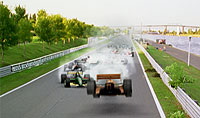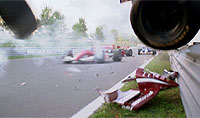A digital car crash blends real-time and slow-motion effects
BY KAREN MOLENBREY
"Director Renny Harlin's vision for the scene was to show the audience what a driver sees and feels during a crash," says Ray McIntyre Jr., visual-effects supervisor at Pixel Magic (Toluca Lake, CA), which created the digital effects for the scene. "We did this by mixing real-time and slow-motion effects. Everything occurring around the crash-such as the other cars moving on the track-is in real time, but the entire accident itself unfolds in slow motion. When Renny explained his idea, we thought it might look odd, but once we did it, we knew it was a brilliant idea."
Pixel Magic created 50 digital-effects shots for the movie, nearly all of which are for the mixed-motion collision and a similar crash that appears later in the film. Other studios also contributed effects that are dispersed throughout the film, mostly involving back ground elements. In Pixel Magic's blended-time sequence, the character Memo Moreno brushes wheels with another racer. At 150 mph in the open-wheeled race car he is driving, it's enough to send his car skidding into a guardrail, then flying back above the racetrack as debris from the impact scatters in all directions. At the precise moment the car lands, another car strikes it, and the impact catapults it back into the air, before it cartwheels off the track and into the grassy infield.
Poetic Motion
To simulate this scene from the driver's point of view also required digital intervention. First, the Pixel Magic team replicated the scene elements, such as the guardrail, track, and sky, using NewTek's LightWave running on Windows NT-based workstations. The artists then "projection-mapped" the filmed image of the guardrail on to the digital scene, which enabled them to create a computer-generated background more easily than modeling from scratch. "The computer-generated geometry had to match the film plates the director gave us, so we could put a camera move into each plate that simply didn't exist," says McIntyre. "This enabled us to generate the new camera moves for the sequence."
During the crash, the camera moves between an observer's viewpoint to the driver's point of view, then back to that of the observer. To find out what a crash might look like from the driver's level, the animators reviewed film footage of actual races and shots of crashes taken by trackside cameras.
"Renny really wanted one continuous camera motion for the entire sequence, which wouldn't have been possible without reshooting the sequence based on [digital] previews that we had made. And even then, it might not have been possible," says McIntyre. "Instead, compositing supervisor Todd Vaziri developed a transition that we coined "the slingshot," which takes you from one side of the track to the other. During this transition, Vaziri added a slight vibration to the image, and then the lens zooms in really quickly to the driver's point of view."
With Adobe Systems' Photoshop, the artists textured the 3D vehicles, using photographs of the real vehicles for reference. Then they added dirt and grime so that the CG cars would blend into the scene immediately following the shots with the real vehicles. All the digital elements, including the shadows, were rendered separately and then composited with Adobe Systems' After Effects. As a result, many shots contained more than 100 elements. Although time-consuming, rendering separate passes enabled the compositor to control the color and saturation of each car and the amount of debris. "I'm not sure that anyone has ever done a slow-motion car crash like this before," says Jennings. "The execution of the car crash, with the ensuing debris and sparks, as well as the alteration of time, gives the scene a very poetic and ballet-like feel. It's an odd way to describe a car crash, but it's really quite beautiful."
Computer Graphics World Magazine, User Focus (Film), June 2001 Pixel Magic's web page: http://www.pixelmagicfx.com |





